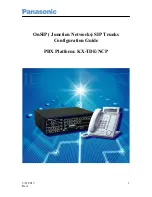
2.1 System Configuration—Hardware
216
Feature Guide
2.1
System Configuration—Hardware
2.1.1
Extension Port Configuration
Description
There are five types of extension ports, used to connect digital proprietary telephones (DPTs), analog
proprietary telephones (APTs), single line telephones (SLTs), Cell Stations (CSs), DSS Consoles, and Voice
Processing Systems (VPS) to the PBX. The devices which can be connected to each type of port are listed
below.
a)
DPT Port:
DPT, CS, DSS Console, and Panasonic VPS which supports DPT (Digital) Integration
b)
APT Port:
APT, DSS Console, and VPS which supports DPT (Digital) Integration
c)
SLT Port:
SLT and VPS which supports DTMF Integration
d)
Hybrid Port:
APT, SLT, CS, DSS Console, and VPS
e)
Super Hybrid Port:
DPT, APT, SLT, CS, DSS Console, and VPS
EXtra Device Port (XDP):
A Super Hybrid port can be used as an XDP port, allowing two telephones (a DPT and an SLT) to be
connected to the same port of the PBX. This XDP port can be used in one of the following modes:
Conditions
•
Automatic Detection on Hybrid/Super Hybrid Port
A Hybrid port supports connecting an APT, SLT, or CS with no programming required.
A Super Hybrid port supports connecting a DPT, APT, SLT, or CS with no programming required.
•
A DSS Console or a Panasonic VPS which supports DPT (Digital) Integration can also be connected
with an SLT in XDP mode.
•
APT and SLT in Parallel Mode
An APT and an SLT can also be connected to a Super Hybrid port and used in parallel mode.
•
Digital XDP
A DPT can be connected to another DPT and act as an independent extension with its own extension
number. (
→
•
Wireless XDP Parallel Mode
A PS can be used in Wireless XDP Parallel mode with a wired telephone.
(
→
1.20.3 Wireless XDP Parallel Mode)
•
DSS Console and Paired Telephone Assignment
When a DSS Console is connected, a PT must be paired with the DSS Console through system
programming (
→
Console Paired Telephone [007]).
Mode
Description
XDP Mode
The DPT and SLT have
different extension numbers
and act as independent
extensions. To use XDP mode, XDP mode must be enabled for the port through
system programming (
→
EXtra Device Port (XDP) Mode [600]).
XDP Parallel Mode
The DPT and an SLT share the
same extension number
so that they can act as
one extension. The SLT uses the extension data (extension number, Class of
Service [COS], etc.) of the DPT. (
→
Summary of Contents for KX-TDA50
Page 16: ...16 Feature Guide...
Page 17: ...Feature Guide 17 Section 1 Call Handling Features...
Page 67: ...1 5 Making Call Features Feature Guide 67 User Manual References 1 2 1 Basic Calling...
Page 215: ...Feature Guide 215 Section 2 System Configuration and Administration Features...
Page 244: ...2 4 Fault Recovery Diagnostics 244 Feature Guide...
Page 245: ...Feature Guide 245 Section 3 Programming Instructions...
Page 281: ...Feature Guide 281 Section 4 KX TDA50 Maintenance Console Operating Instructions...
Page 446: ...4 8 System 2 446 Feature Guide Feature Guide References 1 16 1 Caller ID...
Page 621: ...4 14 ARS 8 Feature Guide 621 Feature Guide References 1 9 1 Automatic Route Selection ARS...
Page 652: ...4 17 Maintenance 11 652 Feature Guide...
Page 653: ...Feature Guide 653 Section 5 Appendix...
Page 661: ...Feature Guide 661 Index...
Page 667: ...Index Feature Guide 667...



































